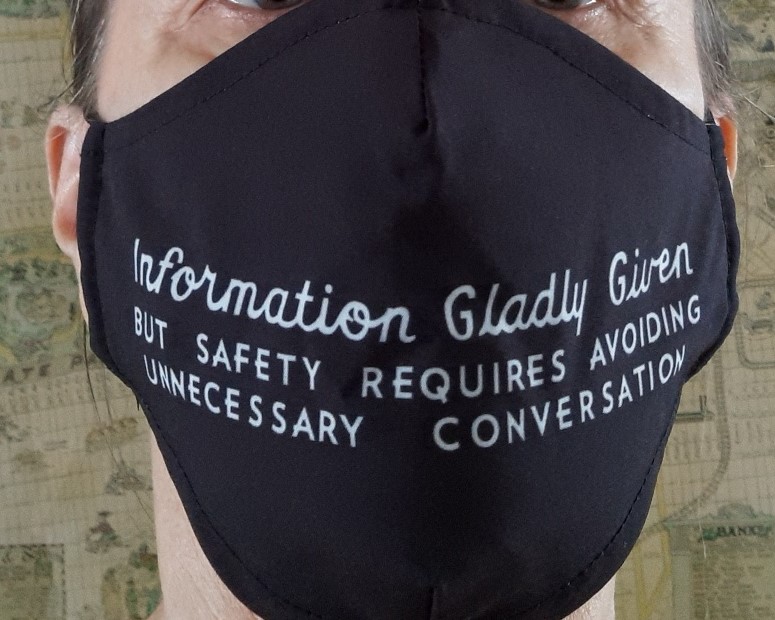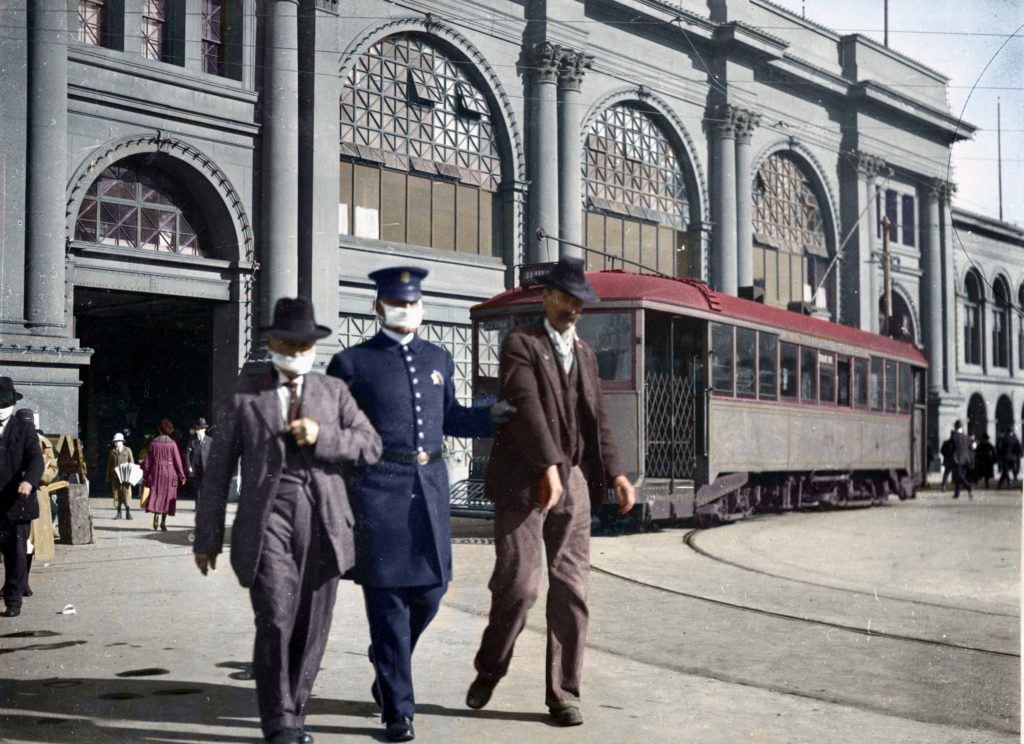
The Bay Area’s transit agencies are slowly restoring service after deep cutbacks triggered by the shelter-in-place orders imposed in mid-March. Muni, for example, dropped from about 80 lines to just seven, with all rail service, including the historic streetcars and cable cars, suspended. San Franciscans have been ordered to wear masks whenever they’re in public places. (We have history-inspired masks at our store.)
We dug into newspaper archives to compare the impacts on San Francisco transit from the influenza pandemic of 1918 and today’s fight against Covid-19.
War and flu
As Fall 1918 began in San Francisco, the Chronicle and Examiner were both filled with reports of the Allied drive toward victory in Europe in what was then called the Great War. The stories filled page after page and went into minute detail. Another story was gaining daily headlines on the East Coast at the time, but getting short shrift here. On September 29, the Examiner ran a tiny story at the bottom of page 2: “BOSTON – At least 85,000 are ill from Spanish influenza in Massachusetts, and the death list is growing hourly…” This followed another small story three days earlier headlined “Two Suspected Cases Influenza are Found in S.F.”
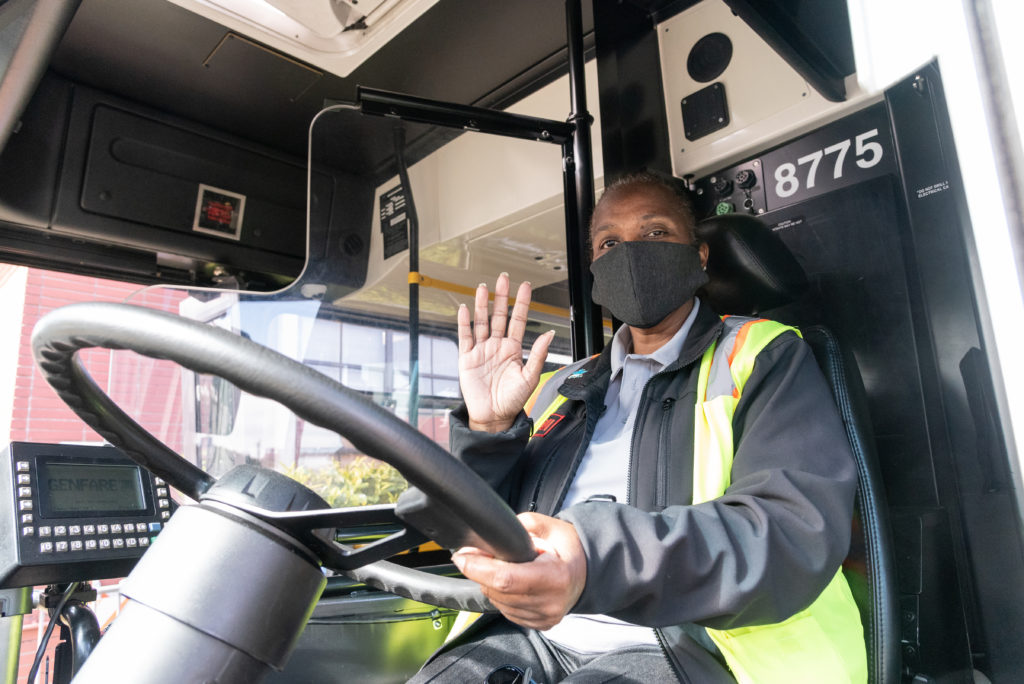
Other than one outbreak in Seattle, blamed on visiting sailors, the West Coast had seen little of the influenza that was ravaging the East Coast and indeed most of the world. That Seattle outbreak, and similar ones in the east apparently triggered by sailors, may well have influenced San Francisco’s public health director, William Hassler, to quarantine all naval installations on September 21, even before a single case had been reported on the bases or in the city. According to John M. Barry, author of The Great Influenza, a history of the 1918 pandemic, Hassler “mobilized the entire city in advance, recruiting hundreds of drivers and volunteers and dividing the city into districts, each with its own medical personnel, phones, transport and supply, and emergency hospitals in schools and churches. He closed public places [including schools]. And far from the usual assurances that the disease was ordinary ‘la grippe,’ on October 22 the mayor, Hassler, the Red Cross, the Chamber of Commerce, and the Labor Council jointly declared in a full-page newspaper ad, ‘Wear a mask and save your life!’ claiming that it was ‘99% proof against influenza.’”
Masks on!
Two days later, masks were not just a recommendation. The city imposed what the Chronicle headlined as a “drastic new ordinance” requiring everyone to wear gauze masks in public “until the danger is past.” Violating the mask rule could bring fines ranging from $5 to $100 could be levied ($85-$2550 in today’s dollars), and up to ten days imprisonment. Though the news merited banner headlines, they were reserved for the second section of the newspaper, not Page One, where war news continued to dominate. The main article on the mask ordinance listed other emergency measures being taken, including opening “the Sacramento Street car barn…as a temporary hospital”. Presumably, this was the United Railroads’ cable car barn at Sacramento and Walnut Streets, which on April 18, 1906, housed (and thus saved) the cable cars now used on the Powell lines, but was not much used by the company then.
Advertisements in the newspapers seemed to convey the stressful times more than the news columns did. Department stores, including I. Magnin and O’Connor, Moffatt (where Macy’s is now) assured their patrons that they could shop “in perfect safety” because their clerks were wearing masks. A maker of loganberry juice touted it “for fever in influenza”. Pacific Telephone & Telegraph ran daily ads for a time, beseeching people to restrict their use of the phone in that pre-dial era because “of the large number of operators now absent because of illness” (as many as 700 at one point).
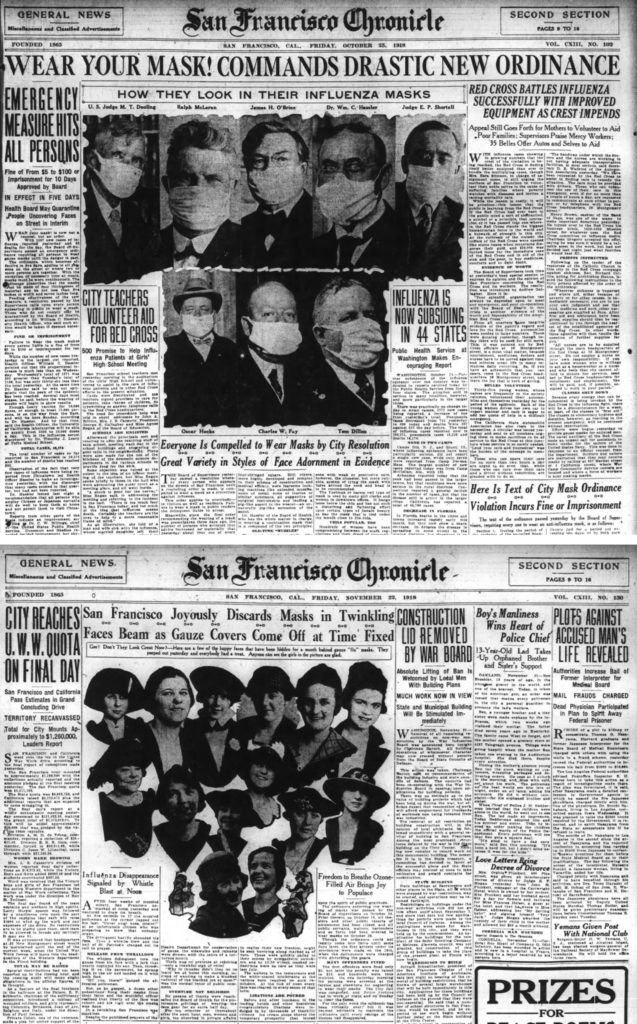
What we didn’t find in either newspaper was even a single mention of how the city’s transit companies were handling the mask ordinance. Police were given enforcement power in San Francisco. In Seattle, streetcar conductors were empowered to deny boarding to passengers without masks. But we found no indication that was imposed in San Francisco. We do know there was stern police enforcement. Reports on November 9 indicate the police courts were clogged with 1,000 “mask slackers,” including 100 at the Ferry Building alone. Most received the minimum fine, but one man was sentenced to 60 days in county jail for “denouncing the government and declaring he did not intend to wear a gauze mask.” Another man, who spit on the sidewalk when a cop told him to get a mask, got ten days behind bars.
Transit suffers
So, if there were altercations on San Francisco transit vehicles over mask wearing, we didn’t find newspaper coverage of them. We do know, however, that the flu clearly affected the transit system. A tiny story in the October 27 edition of the Examiner states that Muni receipts had dropped 20 percent from the preceding week. Muni Superintendent Fred Boeken told the paper, “People are not traveling any more than is actually necessary.” The article then noted “The Municipal car men have also been hit hard with influenza and 139 men have been reported sick.” That was a substantial portion of Muni’s workforce at the time. A November 28 article reported that Muni was considering raising its fare from five cents to six because of the revenue shortfall, but that never came to pass. That same article said the much larger United Railroads “suffered in proportion” to Muni, but offered no specifics.
Meanwhile…
Our newspaper archive search also turned up some other transit news during that three-month period. We saw four articles about streetcars fatally striking pedestrians; all the motormen were arrested for manslaughter. A sailor fell off an E-Union line “dinky” (identical to preserved Car 578) at Larkin and Green and died. A woman riding in an automobile was killed when it plowed into an A-Geary car stopped for the C-line switch at 2nd Avenue. A 22-Fillmore United Railroads car had a fuse catch fire; URR management said the motorman panicked; the car ran away downhill from Haight to Duboce, where it jumped the track; 20 people were hurt. A California Street cable car hit a pedestrian inbound at Powell and then slid down the hill to Stockton, terrifying riders. United Railroads sued the city for building the outside tracks for Muni streetcars along Market Street, claiming violation of their franchise rights (they lost). But in the western part of town, URR had agreed to share tracks with Muni on part of Taraval and Junipero Serra to allow creation of the L-line and the extension of the K, and a contract was awarded in this period to rebuild those dilapidated tracks to Muni standards. The Board of Supervisors discussed a claim by R. C. Storrie & Co., the contractor of the newly-completed Twin Peaks Tunnel, against the city. (Storrie is the guy who named a street created above the tunnel alignment near Castro after himself.)
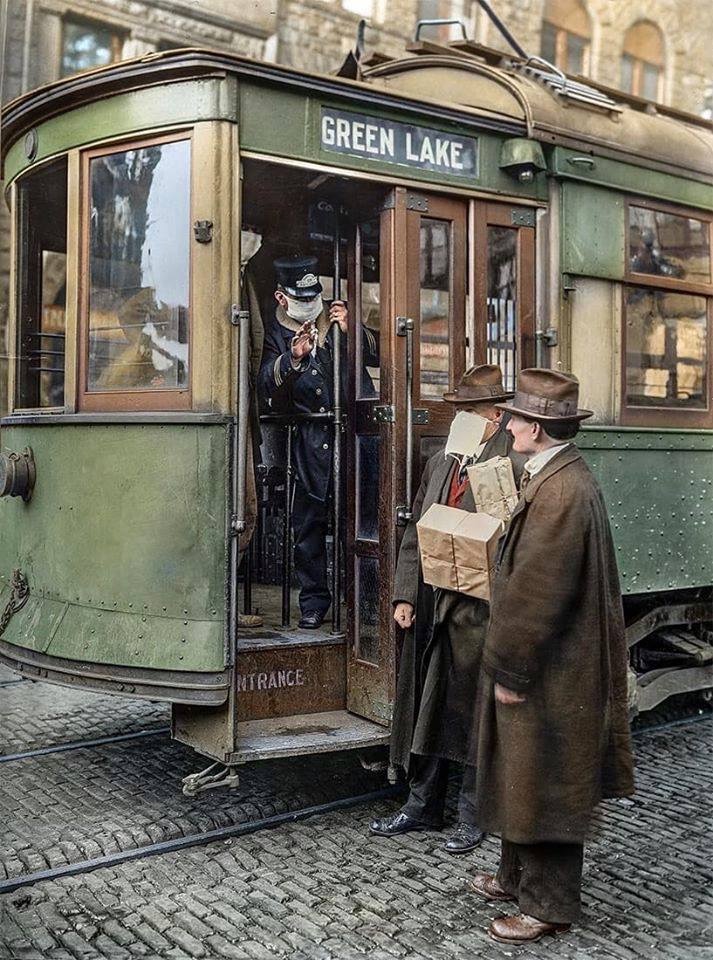
In other news we saw, City Engineer M.M. O’Shaughnessy personally took an axe to a 150-foot tall fir at Hetch Hetchy to provide the city’s “Yuletide Tree” for Civic Center Plaza. The Examiner, which sponsored the tree, claimed it was the largest tree ever publicly erected at that time. A. P. Giannini bought a tavern at Powell and Market Streets, next to the cable car turntable, promising to replace it with a grand headquarters for Bank of Italy. That handsome building still flanks the turntable, now occupied by AT&T. Four prisoners escaped on a raft from Alcatraz, then a military prison. Breweries started closing after President Wilson signed the enabling legislation to impose Prohibition effective in June 1919. And the Board of Supervisors passed a resolution calling for a survey to bridge the Golden Gate, to include rail tracks. (The bridge finally opened, without tracks, in 1937.)
Masks off!
As mandatory masking kicked off, the Examiner ran a story on “fashion masks” for women. Cartoonists offered their good-humored take as well. But even as news columns reported the strongest examples of enforcement, a backlash quickly developed among some San Franciscans hostile toward the requirement. A group called the “Anti-Mask League” pressured politicians, including Mayor Rolph, to end the requirement. Health officer Hassler felt the pressure and introduced an ordinance to do just that, noting that his precautions, including the masks, had likely cut the number of cases and deaths in half. (The city’s reported flu death toll through November 20 was just under 2,000.)
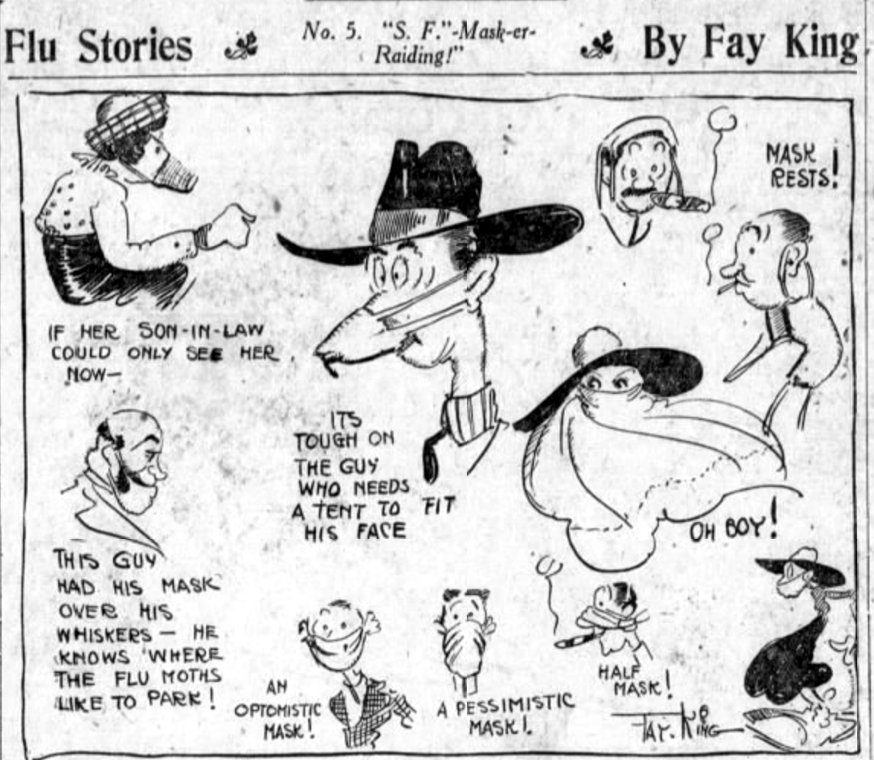
At high noon on November 21, less than a month after masks were required, sirens and whistles sounded across the city and, virtually as one, San Franciscans unmasked. Hassler had urged people to keep their masks handy, just in case, but many if not most were immediately discarded into the streets. “Freedom to Breathe Ozone-Filled Air Brings Joy to Populace”, headlined the Chronicle, which also noted “libations were poured”. An Examiner headline read “Flu Mask Wearers Get ‘Bawling Out’” with the sub-headline “Those who do not doff gauze are ridiculed”, reporting that people who prudently kept their masks on were being mocked by strangers on the street. Examiner columnist “Annie Laurie” laid it on thick: “Didn’t you hate your mask? Didn’t you feel smothered and breathless—and shut up and tied down with a mask on?…The war is over, the flu is conquered. Our masks are off. Come, altogether, now – smile, smile, smile. And with that smile conquer fear and down pain and shake distrust and timorous caution to the four winds.”
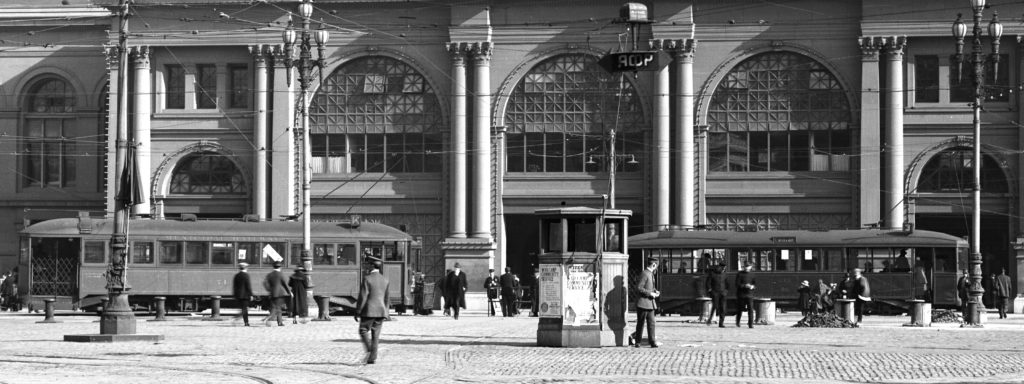
Two weeks later, the final wave of flu hit San Francisco hard. Yet it was clear to the political leadership that masks were hated, and they delayed re-imposing mandatory masking for a full month, until mid-January 1919. Many refused to comply with the second mask ordinance. The Anti-Mask League held a rally at Dreamland on January 24, drawing some 2,000 mask opponents. But by this time, the disease was waning of its own accord, having “burned through” a high percentage of people worldwide. San Francisco’s mask ordinance was rescinded in early February 1919, not to reappear for more than a century.
The toll
The final tally showed San Francisco’s total death toll above 3,200 (in a population of 550,000), the highest on the West Coast. While much has been written about the city’s pioneering embrace of mandatory masks, less has been said about Hassler’s early actions to restrict public gatherings. Cities that didn’t, most notably Philadelphia, suffered greatly.
No one at the time understood that influenza, like Covid-19, is a virus. Few saw the health imperative of keeping people distanced from each other and, indeed, it was a practical impossibility. Few if any people could work from home; you had to go out to shop; only the wealthy could shun public transit for their private automobiles. So, almost all businesses stayed open and people kept riding the streetcars, although limiting their trips, as we have seen.
As we post this story (which originally appeared in our member magazine Inside Track), masks remain required in public places in San Francisco and surrounding counties. After five months with no rail service at all, Muni tried to reopen its subway under Market Street only to shut it down again after a couple of days, in part because a positive Covid-19 test came back or a key employee in their rail operations center.
We look forward to the day when all San Francisco transit, including the historic streetcars and cable cars, can resume operation safely for both operators and passengers, and our San Francisco Railway Museum is allowed to reopen. Meanwhile, you can support our nonprofit by shopping at our online store and purchasing among other items, yes, masks.
